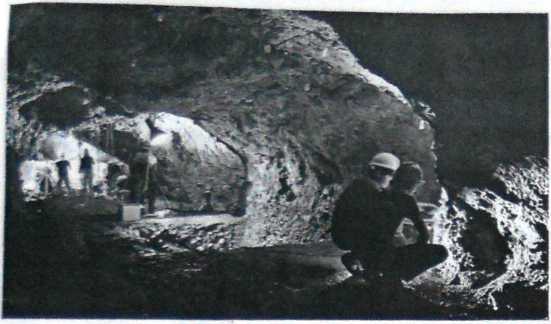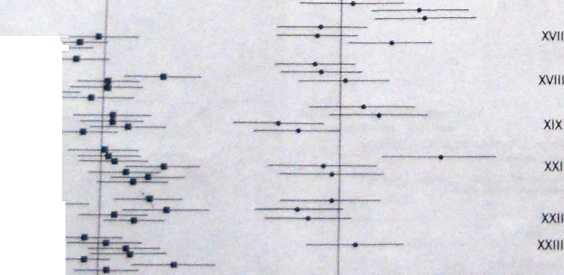DSCN4037
183
Methods of dating

Measurements being taken In Pontnewydd Cave, North Wales, where a homlnld molar of eariy Neanderthal type and assoclated Acheulean stone tools were found In 1981. The lowermost archaeological layers were shown by uranium disequilibrium dating of a stalagmite to be at least 220000 years old. Thls datę was confirmed by thermoluminescence measurements on the same stalagmite and on a bumt flint.
Hetera Oafzeb
Layer

Under radioactive equiłibrium, the radioactivities of each ofthe decay products in the series are equal. However, these decay products may be separated from each other by processes such as weathering, differential adsorption, crystallisation of minerals that incorporate one element but esclude another and various biological events to form a system that is out of equilibrium. How much out of equilibrium is a measure of the time when the series was disrupted.
Uranium-disequilibrium dating systems, especially those that depend on the ratio between and ^U, have been applied to non-rnanhe carbonates; such as~calciteTn~ caves. The half-life for this process is 248000 years so that the method has a rangę of about 1 million years.
60 70 ~80 90 100 110 120
Agę (thousands of years ago)
Thermoluminescence ages of burnt fllnts from Kebara and Qafzeh caves, Israel, for which the external dose was measured by burylng dosimeters at the siłę. Neanderthal fosslls were recovered at Kebara (the younger site), whereas eariy modern human fosslls were found at Qafzeh.
The related thorium-2jo/uranium-2j4 (2MTh/1,4U) method is also used to datę inorganic carbonates. like other uranium-series methods, it depends on the high solubility of uranium in water. Thus, ground and surface water seeping into limestone caves usuaiły contains uranium but not its daughter isotopes, such as 250Th, which are relatively insoluble. Once crystals of calcite precipitate as stalactites and stalagmites on the cave walłs and fioors, however, ““Th starts accumula ling as the result of the decay of^U and 25 ®U and this continues until equi1ibrium is reached. The ratio of 2S0Th to 234U provides a measure of the time that has elapsed sińce crystal formation.
The 23°Th/234U method is useful for minerał samples younger than 300000 years and has been applied to cave sites in Europę that were once occupied by eariy Homo sapiens, where there are no volcanic rocks suitable for dating by the potassium-argon method. These indude Bilzingsleben (Germany), Vertesszóllos (Hungary) and Pontnewydd (Wales), which have ages of 300000 to 200000 years.
Uranium-series dating of archaeological remains in caves can be prone to error because of possible difficulties in working out the order of calcite deposition, especially where fragments of caye wali have broken off and layers have become mixed up. There is also the possibility that the dated calcite was contaminated by uranium from an extemal source, such as dust particles, or that some of the uranium leached from the carbonate after precipitation. For these reasons, several layers of deposit usually need to be dated and other techniques used to check the results.
Thermoluminescence, optically stimulated luminescence and electron spin resonance
The basis of these methods is the same: they measure the number ofelectrons caught up in defects in the lattice struc-ture of crystals. The defects are caused by decay of smali amounts of radioactive elements such as potassium, thorium and uranium within the crystal. The number of trapped electrons increases with time through exposure to this radiation so that the crystal acts as a dosimeter. Only when the electrons are released from the traps is the clock reset to zero.
In the thermoluminescence (TL) method, the accumu-lated dose of radiation in the crystal lattice is measured by heating the sample to a high temperaturę to excite the trapped electrons. As they escape from the lattice they emit light known as thermoluminescence. The intensity of thermoluminescence is proportional to the number of trapped electrons. The age of the materiał is obtained by dividing the accumulated dose by the annual dose. The latter is determined by measuringthe amount of uranium, thorium and potassium within the sample and in the soil or rock surrounding it, or by irradiating the sample artificially and remeasuring its thermoluminescence. A companion
Wyszukiwarka
Podobne podstrony:
ASTM (2004b). Standard test method for laboratory measurement of impact sound transmission through t
13 Re-shaping the Global Financial Architecture: Dual SIFIs Role for suitable measurement methods o
141 United Kingdom Dutch method of measurlng cone resistance, while the dynamie aspect uses a "
skanowanie0020 (27) Suggestopedia is a method of foreign language teaching developed by the B
Ekonomia polityczna jako nauka i jako sztuka (2) John Neville Keynes (ojciec J. M. Keynesa)- The Sco
Titration acidity was evaluated based on ĆSN 0107: 1966 entitled Methods of evalua-ting cheese, curd
8ANALYSIS, TESTING JPRS-UMS-92-003 16 March 1992 the method of separation of variables and the compu
(„Theory, practice and methodology of fencing: chosen aspects”).- Katowice, Wyda
Czym jest religiologia? 49 Tyloch W. (ed.), Current Progress in the Methodology of the Science of Re
Every method of mapping has its inconsequencies and defects. Klimaszewski distinguishes: forms of de
1933League of Nations — Treaty Series.97 settle amicably by the normal methods of diplomacy shall be
więcej podobnych podstron